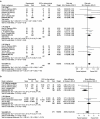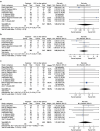Evaluation of favipiravir in the treatment of COVID-19 based on the real-world
- PMID: 34846960
- PMCID: PMC8787837
- DOI: 10.1080/14787210.2022.2012155
Evaluation of favipiravir in the treatment of COVID-19 based on the real-world
Abstract
Background: The role of favipiravir (FVP) as a COVID-19 treatment is recognized but not fully elucidated. We aimed to evaluate whether FVP has definite clinical efficacy and safety in the treatment of COVID-19.
Methods: International and Chinese databases were searched for randomized controlled clinical trials evaluating FVP for the treatment of COVID-19. A meta-analysis was performed and published literature was synthesized to evaluate the corresponding therapeutic effects.
Results: We included 13 studies (1430 patients in total). Meta-analysis showed that patients with mild-to-moderate disease treated with FVP had a significantly higher viral clearance rate than those in the control group 10 and 14 days after initiation of treatment [RR: 1.13 (95% CI: 1.00, 1.28), P = 0.04; I2 = 39% for day 10 and RR: 1.16 (95% CI: 1.04, 1.30), P = 0.008; I2 = 38% for day 14] and a significantly shorter hospital stay [MD: -1.52 (95% CI: -2.82, -0.23), P = 0.02; I2 = 0%].
Conclusions: FVP significantly promotes viral clearance and reduces the hospitalization duration in mild-to-moderate COVID-19 patients, which can reduce the risk of severe disease outcomes in patients. However, more importantly, the results showed no benefit of FVP in severe patients, and caution should be taken regarding the treatment options of FVP in severe patients.
Keywords: Antiviral agents; covid-19; favipiravir; meta-analysis; viral clearance.
Plain language summary
PLAIN LANGUAGE SUMMARYThe urgent need to identify effective interventions to treat novel coronavirus infections is a major challenge. The role of favipiravir (FVP) as a COVID-19 treatment is recognized but not fully elucidated. Our study showed a significant correlation between viral clearance and the promotion of clinical improvement with FVP in mild-to-moderate patients, which is significant for reducing the length of hospital stay of patients, reducing the risk of patients progressing to severe disease, thereby reducing mortality. However, the results showed no benefit of FVP in severe patients and the conclusion of this study still needs to be further verified by clinical trials with large samples.
Figures
References
-
- Geremia N, Vito AD, Gunnella S, et al. A Case of Vasculitis-Like Skin Eruption Associated With COVID-19. Infectious Disease in Clinical Practice. 2020;28(6): e30–e31
Publication types
MeSH terms
Substances
LinkOut - more resources
Full Text Sources



